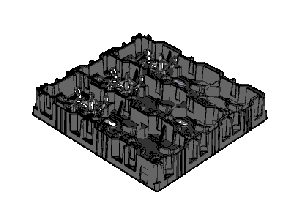What are the Different Types of Pallets?

WHAT ARE THE DIFFERENT TYPES OF PALLETS? AND WHY ARE PLASTIC PALLETS BETTER?
Your business needs pallets, but how do you know which ones to use? There are a number of different ways to classify and distinguish pallets: materials, ways of manufacturing, what they’re used for, and so on. The possibilities seem endless. To help figure out what you need, let’s take a look at some different categories that they can fall into.
At Vantage Plastics, we specialize in pallets. Pallets are how we made our name. Pallets are what we do best. Plastic pallets, specifically.
PALLET MATERIALS
The first, most obvious distinction in pallets is between materials: specifically between wood and plastic pallets. Each has its strengths and uses, but that’s a discussion into itself. We’ll only be talking about plastic here.
What plastic is used depends on a number of factors, such as:
- what it’s used for
- What weight does it need to hold
- Does it need to nest
- Does it need to be stacked
- if it needs to be repeatedly reused
- if recycling is desired.
The plastic used in thermoformed pallets can range from HDPE (high-density polyethylene) to ABS (Acrylonitrile-Butadiene-Styrene) to a wide range of materials. One important distinction is between virgin and recycled resins. The virgin resins are new and considered more durable than recycled. However, this makes them more expensive.
PALLET CONSTRUCTION
Two types of thermoformed construction are used with plastic pallets: single and twin sheet.
Single sheet pallets are made with one extruded sheet of plastic. They tend to be less expensive to manufacture and are made for lighter weight (up to 1500 pounds) use. Because their manufacturing process doesn’t involve any hollow areas that can allow microbial growth, they’re perfect for supporting food cargo.
Twin sheet pallets are – as the name suggests – made with two sheets of plastic along with two different molds. They’re mostly used for heavier (1500 to 3000 pounds or more) applications.
PALLET SIZES
Different regions have different specifications for pallet sizes. For example, the CBA (Consumer Brands Association) standard for pallets in North America is 40 by 48 inches. The Australian Standard Pallet (ASP) is a 1165 mm (a little less than 48 inches) square. Sizes vary even more depending on the industry, such as for beverages.
PALLET DESIGN
There are four basic designs for plastic pallets:
- Nestable: These can stack on top of each other and fit together tightly. The advantage here is saving space.
- Stackable: Similar to nestable, but they don’t as tightly. They take up a little more space but are sturdier.
- Display: These are made to be transportable and visible in a retail setting.
- Rackable: Made for easy transport by forklift and potential storage in racks.
PALLET USE
Of course, different industries have their own unique pallet designs. What works for an automotive parts business wouldn’t work for food transportation. For example, the egg industry has very particular requirements for their fragile cargo, such as plastic dividers. Pallets that carry food need to be easily cleaned to prevent the buildup of germs and microbes over time.
THE BOTTOM LINE CONSENSUS: PLASTIC PALLETS ARE BEST
That’s a lot of different categories of pallets. At Vantage Plastics, we are a bit biased and think plastic pallets are best. Here’s why:
- They’re hygienic and safe: Plastic doesn’t absorb moisture and it doesn’t rot like wood. They also don’t require nails to assemble or fracture into dangerous splinters.
- They last longer than wood: At best, a wooden pallet generally only lasts for three to five uses. Plastic pallets have a lifespan that can last for years.
- They’re cheaper in the long run: Because they last so long and are more durable, plastic pallets have a lower cost per trip than wood. And with innovations in plastic manufacturing, expect the upfront cost to continue to decrease.
- If and when plastic pallets come to the end of their lifespan the materials are generally recyclable and can be used to make other products.
CHOOSE A PLASTIC PALLET MANUFACTURER YOU CAN TRUST
At Vantage Plastics, protecting products in transit and in storage is extremely vital. Pallets are vital to that endeavor. Pallets are what we do best. Within our facility, we have eight single-sheet machines, five twin-sheet machines, and one sample machine dedicated to prototype samples.
Anything that needs to be shipped or stored, we can create a pallet for it.
Contact us or call 989-846-1029 to discover how we can serve you!
